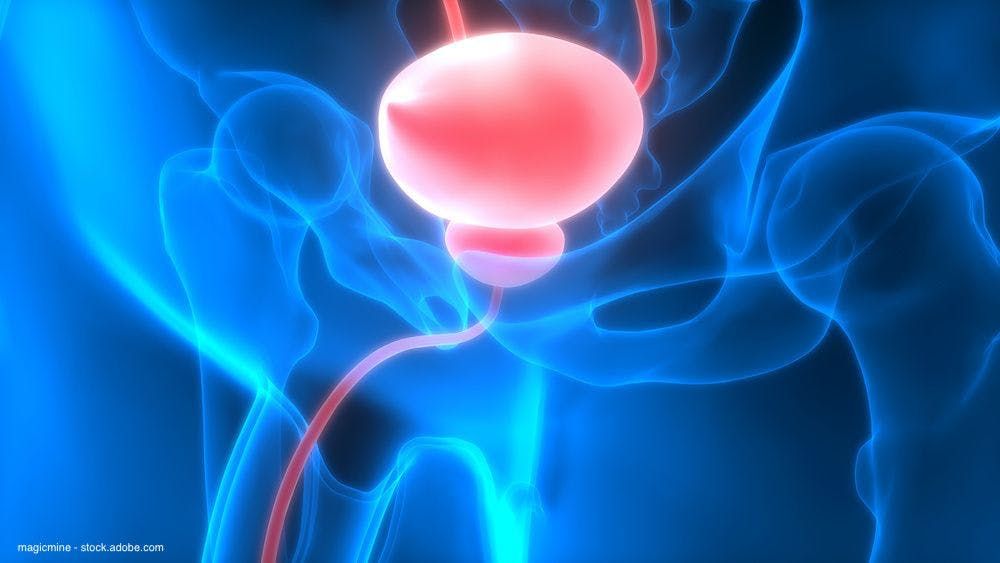Article
Study supports bladder-sparing treatment for patients with node-positive nonmetastatic bladder cancer
Author(s):
“Patients who present with [node-positive nonmetastatic bladder cancer] have a poor prognosis and should be counseled as to the most appropriate treatment, empowering them in their decision making with the knowledge that bladder preservation is a real alternative to radical surgery,” the authors wrote.
All patients with node-positive nonmetastatic bladder cancer should have the option to receive bladder-sparing trimodal therapy (TMT) as an alternative to radical cystectomy, according to a retrospective analysis published in the Journal of Clinical Oncology (JCO).1
In an accompanying commentary on the relevance of this retrospective study, JCO Associate Editor Jonathan P.S. Knisely, MD, wrote, “This analysis provides data that the presence of pelvic lymphadenopathy should not be regarded as a contraindication to trimodality therapy.”

TMT consists of 3-pronged bladder-sparing regimens, such as transurethral resection of bladder tumor (TURBT) following by radical dose radiotherapy (RadRT) with a concurrent radiosensitizing agent (typically chemotherapy). The researchers performed their retrospective study because available data were limited regarding the use of TMT in patients with clinically node-positive bladder cancer (cN1 M0 BCa).
Their analysis included patients with cN1 M0 BCa receiving either radical or palliative treatment. Across the entire population, the median overall survival (OS) was 1.55 years (95% CI, 1.35-1.82). Compared with those receiving palliative treatment, patients treated with radical therapy had a 68% reduced risk of death (HR, 0.32; 95% CI, 0.23-0.44; P <.001).
Further, in the cohort of patients receiving radical therapy, multivariate analysis showed that there was no significant difference in survival outcomes based on choice of radical treatment. Regardless of whether patients received RadRT or radical cystectomy, outcomes were similar for both OS (HR, 0.94; 95% CI, 0.63-1.41; P = .76) and progression-free survival (HR, 0.74; 95% CI, 0.50-1.08; P = .12). Of note, over half of patients treated with RadRT had also been treated with a radiosensitizer, and thus received a bladder-sparing TMT regimen.
“Our data suggest that patients who are able should undergo radical treatment and that survival outcomes are the same regardless of whether RadRT or RC is received. Patients who present with cN1 M0 BCa have a poor prognosis and should be counseled as to the most appropriate treatment, empowering them in their decision making with the knowledge that bladder preservation is a real alternative to radical surgery,” the authors wrote.
Overall, the study included 287 patients diagnosed with cN1 M0 bladder cancer from 2012 to 2021 at 4 oncology centers in the United Kingdom. All patients had received TURBT. Of the 287 patients, 163 had received radical treatment and 124 had received palliative treatment. The researchers subdivided the radical treatment group into 5 treatment categories: systemic anticancer therapy (SACT) and RC; RC alone; SACT and RadRT; RadRT alone; and RC and adjuvant RT.
Of the patients receiving radical treatment, 76 received radical cystectomy and 87 received RadRT. Of the patients treated with RadRT, 46 received a radiosensitizer, consisting of either concurrent chemotherapy (n = 35) or inhaled carbogen (98% O2/2% CO2) and oral nicotinamide (n = 11).
Across the entire cohort of 287 patients, the median patient age was 71 years (range, 63-77), 72% of patients were male, and 28% of patients were female. ECOG performance status was as follows: 0 (35.5%), 1 (32.8%), 2 (20.6%), 3 (8.7%), 4 (1.0%), and not recorded (1.4%). The smoking status was “current/past smoker” for 58.8% of patients. The majority of patients (81.5%) had pure urothelial as their tumor histology. Tumor grades were moderately differentiated (G2; 3.1%), poorly differentiated (G3; 92.7%), undifferentiated (1%), and not recorded (3.1%).
In an accompanying commentary on the relevance of this retrospective study, JCO Associate Editor Jonathan P.S. Knisely, MD, wrote, “This analysis provides data that the presence of pelvic lymphadenopathy should not be regarded as a contraindication to trimodality therapy.”
Reference
1. Swinton M, Mariam NBG, Tan JL, et al. Bladder-Sparing Treatment With Radical Dose Radiotherapy Is an Effective Alternative to Radical Cystectomy in Patients With Clinically Node Positive Nonmetastatic Bladder Cancer [published online ahead of print July 21, 2023]. J Clin Oncol. 2023. doi: 10.1200/JCO.23.00725
Newsletter
Stay current with the latest urology news and practice-changing insights — sign up now for the essential updates every urologist needs.













